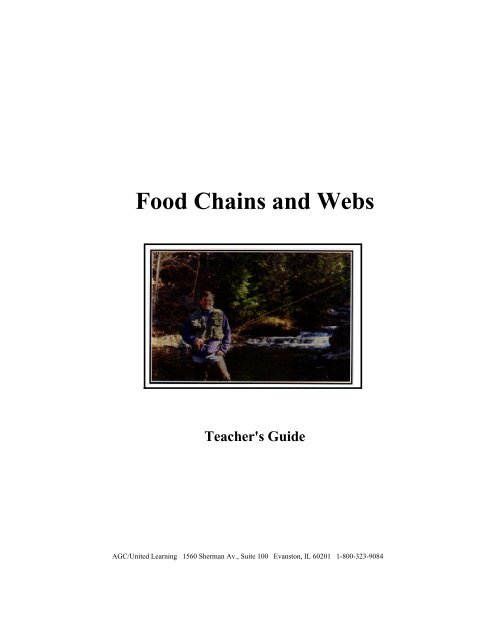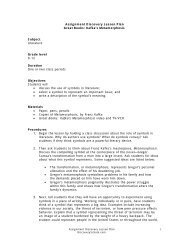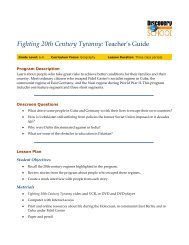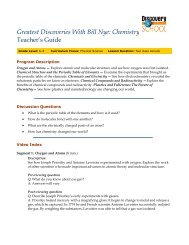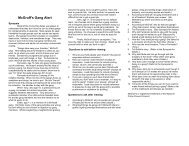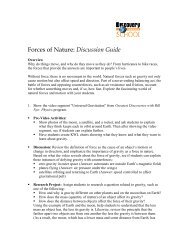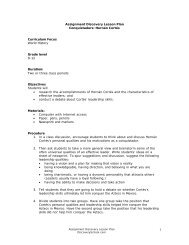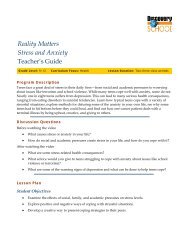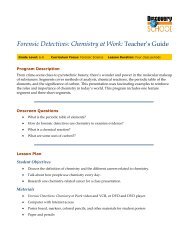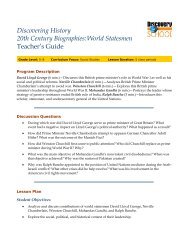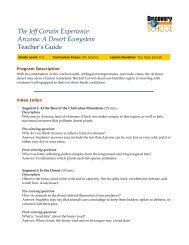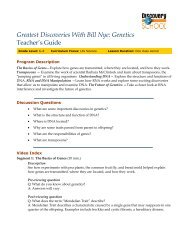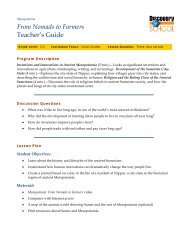Create successful ePaper yourself
Turn your PDF publications into a flip-book with our unique Google optimized e-Paper software.
<strong>Food</strong> <strong>Chains</strong> <strong>and</strong> <strong>Webs</strong><br />
Teacher's Guide<br />
AGC/United Learning 1560 Sherman Av., Suite 100 Evanston, IL 60201 1-800-323-9084<br />
1
<strong>Food</strong> <strong>Chains</strong> <strong>and</strong> <strong>Webs</strong><br />
catalog # 2696<br />
Published & Distributed by…<br />
AGC/UNITED LEARNING<br />
1560 Sherman Avenue<br />
Suite 100<br />
Evanston, IL 60201<br />
1-800-323-9084<br />
24-Hour Fax No. 847-328-6706<br />
<strong>Webs</strong>ite: http://www.agcunitedlearning.com<br />
E-Mail: info@agcunited.com<br />
2<br />
AGC/United Learning 1560 Sherman Av., Suite 100 Evanston, IL 60201 1-800-323-9084
<strong>Food</strong> <strong>Chains</strong> <strong>and</strong> <strong>Webs</strong><br />
Grades 5-8<br />
Viewing Time: 21 minutes<br />
Program Summary<br />
Take your students on a tour of the food chain in this video designed<br />
for students in grades 5 through 8. Come along on an<br />
expedition with Dr. Brian Jerome as he visits Vermont's White<br />
River Watershed, its flowing waters, forests, wetl<strong>and</strong>s, <strong>and</strong> rocky<br />
shores to examine how energy <strong>and</strong> matter are transferred through<br />
the environment. He will explore the relationships between producers<br />
<strong>and</strong> consumers, predators <strong>and</strong> prey, <strong>and</strong> biotic <strong>and</strong> abiotic<br />
factors. Students will learn about food chains <strong>and</strong> webs by studying<br />
the interactions of the plants <strong>and</strong> animals of this region.<br />
Through this video students will learn why food chains <strong>and</strong> webs<br />
are important in their daily lives.<br />
Dr. Brian Jerome takes students on a live-expedition to the White<br />
River in the Green Mountains of Vermont. In his quest to catch a<br />
trout, he shows students the interactions of the many plants <strong>and</strong><br />
animals on the river. Footage includes extensive shots of the<br />
numerous plants in this riparian ecosystem. Plants <strong>and</strong> animals<br />
featured in the video include phytoplankton, cattail, sumac, maple<br />
<strong>and</strong> birch trees, <strong>and</strong> pines, as well as moose, deer, hawks, trout,<br />
nymphs, snakes, squirrels, <strong>and</strong> bears. The intricate web of life is<br />
discussed by illustrating the interactions of these many organisms.<br />
The video is vocabulary-rich <strong>and</strong> uses key terminology, such as<br />
ecosystem, producer, consumer, predator, phytoplankton, herbivore,<br />
carnivore, biomass, trophic level, <strong>and</strong> biomagnification.<br />
Definitions for these terms are provided in the video <strong>and</strong> are also<br />
displayed on the screen.<br />
AGC/United Learning 1560 Sherman Av., Suite 100 Evanston, IL 60201 1-800-323-9084<br />
3
Numerous colorful <strong>and</strong> easy-to-underst<strong>and</strong> graphics greatly enhance<br />
student underst<strong>and</strong>ing of the key concepts involved with<br />
food chain <strong>and</strong> webs. Illustrations of food chains, food webs,<br />
energy pyramids, biomass pyramids, <strong>and</strong> energy loss highlight<br />
real-life examples along the White River.<br />
In addition, the negative effects of pesticides on the food chain<br />
are highlighted through a discussion of Rachel Carson's crusade<br />
to end the use of DDT. Positive steps toward revitalizing food<br />
chains are also examined through a look at the Atlantic Salmon<br />
Restoration Program on the White River.<br />
Student Objectives<br />
After viewing the video <strong>and</strong> completing the lessons <strong>and</strong> activities,<br />
students will be able to…<br />
• Provide examples of the plants <strong>and</strong> animals that live in an ecosystem<br />
such as the White River riparian ecosystem.<br />
• Define the vocabulary words addressed in the video <strong>and</strong> in the<br />
Word Search Activity.<br />
• Describe how producers are at the base of most food chains <strong>and</strong><br />
webs.<br />
• Given several organisms, arrange them correctly in a food chain<br />
or food web.<br />
• Define <strong>and</strong> identify herbivores, carnivores, <strong>and</strong> omnivores in a<br />
food chain or web.<br />
• Describe the role of decomposers in food chains <strong>and</strong> webs, <strong>and</strong><br />
how they promote the cycling of matter.<br />
4<br />
AGC/United Learning 1560 Sherman Av., Suite 100 Evanston, IL 60201 1-800-323-9084
Teacher Preparation<br />
Before showing this program to your students, it is suggested<br />
that you preview the video, <strong>and</strong> review this guide. Duplicate any<br />
blackline masters you wish to distribute.<br />
Decide with which concepts <strong>and</strong> vocabulary students may be<br />
unfamiliar, <strong>and</strong> review this information prior to showing the video.<br />
It should be noted that there are a large number of organisms<br />
which participate in food chains <strong>and</strong> food webs. The types of<br />
organisms largely depends on geographic location. Student exposure<br />
to various organisms may vary widely depending on where<br />
they live, <strong>and</strong> their awareness of the natural world.<br />
No matter where they live, plants <strong>and</strong> animals form some type of<br />
food chain or web. Attempt to make students aware of the organisms<br />
in their neighborhood, <strong>and</strong> how they interact with each other<br />
by discussing them before viewing the video.<br />
You may decide to duplicate <strong>and</strong> distribute some of the blackline<br />
masters so that students can reference them during the video program.<br />
You are encouraged to tailor the video <strong>and</strong> accompanying<br />
blackline masters to the needs of your students, <strong>and</strong> your instructional<br />
needs. It is hoped that the video <strong>and</strong> blackline masters<br />
serve as a starting point for additional discussion <strong>and</strong> learning<br />
about this fascinating topic.<br />
The video presentation is followed by a Video Quiz. The questions<br />
from the video quiz may be used as a pre-test to gauge student<br />
comprehension. These questions appear on Blackline Master<br />
1, Video Quiz. The answers appear in the Answer Key on<br />
page 8.<br />
AGC/United Learning 1560 Sherman Av., Suite 100 Evanston, IL 60201 1-800-323-9084<br />
5
Introducing the Video<br />
Before showing students the video you may want to discuss with<br />
students the needs of living things. Discuss that living organisms<br />
need energy to carry out functions. Also, discuss how living<br />
organisms go about obtaining or producing organisms. Highlight<br />
the differences between plants which produce their own food,<br />
<strong>and</strong> animals which must eat plants or other organisms to obtain<br />
their energy.<br />
Students may not be familiar with much of the terminology in<br />
the video. You may want to review the spelling <strong>and</strong> pronunciation<br />
of terms, such as consumer, producer, photosynthesis, carnivore,<br />
herbivore, biomass, <strong>and</strong> energy. You also may want to discuss<br />
the meaning of many of these terms.<br />
The majority of the video was filmed on location in central Vermont.<br />
Point out to students on a United States map the location<br />
of Vermont. On a more detailed map of New Engl<strong>and</strong> you may<br />
want to point out the location of the White River, running from<br />
above Rochester, Vermont to its confluence with the Connecticut<br />
river near White River Junction, Vermont. Point out the eventual<br />
mouth of the Connecticut River in Long Isl<strong>and</strong> Sound.<br />
Ask students what they think a "food chain" is. Do they play a<br />
role in food chains <strong>and</strong> webs? If so, what role(s)? Compare their<br />
answers to these questions before <strong>and</strong> after participating in the<br />
lesson.<br />
Present the video. The viewing time is 21:00.<br />
Follow-Up Activities<br />
Discussion<br />
Following the video, students may have additional questions.<br />
Allow time for students to air their questions. Avoid answering<br />
the students' questions directly; ask them additional questions<br />
6<br />
AGC/United Learning 1560 Sherman Av., Suite 100 Evanston, IL 60201 1-800-323-9084
leading them to the answers on their own, or encourage other<br />
students in the class to answer questions.<br />
There are numerous issues which may warrant further questions.<br />
As a class you may want to discuss the following:<br />
• What is an ecosystem? What ecosystems are located in your<br />
area?<br />
• What are the differences between producers <strong>and</strong> consumers?<br />
What are some examples of each in your area?<br />
• Why in healthy ecosystems, does there tend to be a much greater<br />
biomass of producers than consumers?<br />
• Some people argue that one of the ways to battle world hunger<br />
<strong>and</strong> to provide a greater amount of food to a growing world population,<br />
is to encourage people to eat more producers, such as fruits<br />
<strong>and</strong> vegetables. Discuss the issue in terms of energy loss along<br />
the food chain.<br />
• Discuss the plants <strong>and</strong> animals that make up the food web immediately<br />
surrounding the school. Create a diagram on a chalkboard<br />
or overhead.<br />
• What are some examples of food webs that are badly damaged<br />
by either animal extinction or the introduction of exotic organisms<br />
into the food web? Discuss how this affects other organisms<br />
in the food web.<br />
Field Trip Opportunities<br />
Depending on the part of the country in which you reside, there<br />
may be many opportunities to take your class on field trips to<br />
sites which highlight food chains <strong>and</strong> webs. There may be natural<br />
areas or parks close by where students can observe the plants<br />
<strong>and</strong> animals which make up food chains <strong>and</strong> webs. Schools in<br />
urban environments might be able to visit a park or playground<br />
where they can observe food chains or webs in action.<br />
AGC/United Learning 1560 Sherman Av., Suite 100 Evanston, IL 60201 1-800-323-9084<br />
7
Local science museums may have exhibits describing food chains<br />
or webs. It might also be interesting to visit a grocery store or<br />
school cafeteria where students can see how the foods they eat fit<br />
into food chains <strong>and</strong> webs. Here they could create food chain<br />
<strong>and</strong> web diagrams from common everyday foods.<br />
Topics for Further Research<br />
The following topics would make good topics for research<br />
papers, plays, creative writing exercises, <strong>and</strong> art projects:<br />
• How have food webs changed over the past 200 years in your<br />
region?<br />
• Describe the role of pesticides <strong>and</strong> other toxins in food webs.<br />
• Read <strong>and</strong> report on Rachel Carson's book Silent Spring.<br />
• Chose a part of the world under severe environmental degradation,<br />
such as the rain forests of Central <strong>and</strong> South America, <strong>and</strong><br />
create diagrams of food webs before <strong>and</strong> after deforestation.<br />
• Write a song or poem about a food web in the area.<br />
• Take photographs or draw pictures of animals in a food web<br />
from which a bulletin board display can be made.<br />
• Investigate how habitat enhancement can change the interactions<br />
of organisms in food webs.<br />
• Compare <strong>and</strong> contrast food webs in different ecosystems, such<br />
as between a deep ocean ecosystem <strong>and</strong> a prairie ecosystem.<br />
Blackline Masters<br />
Answers to all Blackline Master activities appear in the Answer<br />
Key on page 8.<br />
• Distribute Blackline Master 1, Quiz. The questions on this<br />
sheet replicate the questions in the Video Quiz at the end of the<br />
presentation. You may use it as a pre-test <strong>and</strong>/or post-test to gauge<br />
student comprehension.<br />
• Distribute Blackline Master 2, Chaining It Together. This<br />
activity provides students with the components of a simple uni-<br />
8<br />
AGC/United Learning 1560 Sherman Av., Suite 100 Evanston, IL 60201 1-800-323-9084
directional food chain to model. It also asks that they identify<br />
consumers <strong>and</strong> producers, as well as trophic levels, within the<br />
food chain.<br />
• Distribute Blackline Master 3, Web Weaving. This activity<br />
provides students with the components of a more complicated<br />
multi-directional food web to model. It also asks that they add<br />
decomposers to the model, <strong>and</strong> that they identify how this food<br />
web may be different from those found in their region.<br />
• Distribute Blackline Master 4, Word Search, a fun activity<br />
that asks students to locate hidden vocabulary words.<br />
• Distribute Blackline Master 5, Vocabulary Words <strong>and</strong> Definitions.<br />
This exercise asks students to provide definitions of the<br />
vocabulary words fundamental to the program.<br />
• Distribute Blackline Master 6, Field Form For <strong>Food</strong> <strong>Webs</strong>,<br />
provides students with a chart to complete based on the organisms<br />
indigenous to your region. Once organisms have been identified<br />
as consumers or producers, from where they derive their<br />
energy, <strong>and</strong> for whom they serve as food, students are asked to<br />
incorporate them into a food web diagram.<br />
• Distribute Blackline Master 7, The Big Picture. This exercise<br />
asks students to think of the cycling of matter <strong>and</strong> the flow of<br />
energy in food webs. It also asks that they define <strong>and</strong> examine<br />
biomagnification as it applies to the introduction of harmful<br />
chemicals into ecosystems.<br />
• Distribute Blackline Master 8, Name That Critter, asks students<br />
to identify several anonymous organisms based on clues,<br />
<strong>and</strong> to identify the organisms as producers or consumers, <strong>and</strong> as<br />
herbivores, carnivores, or omnivores.<br />
AGC/United Learning 1560 Sherman Av., Suite 100 Evanston, IL 60201 1-800-323-9084<br />
9
Answer Key<br />
Blackline Master 1, Video Quiz<br />
1. ecosystem<br />
2. producers<br />
3. consumers<br />
4. carnivores<br />
5. web<br />
6. trophic<br />
7. matter<br />
8. decomposers<br />
9. heat<br />
10. less<br />
Blackline Master 2, Chaining It Together<br />
1. Student diagrams of the food chain should look similar to the<br />
following:<br />
2. Student diagrams should look like the above with phytoplankton<br />
labeled producer, <strong>and</strong> all other organisms labeled consumer.<br />
3. The food chain should be labeled as follows: Phytoplankton -<br />
First Trophic Level, Nymph - Second Trophic Level, Trout - Third<br />
Trophic Level, Heron - Fourth Trophic Level<br />
10<br />
AGC/United Learning 1560 Sherman Av., Suite 100 Evanston, IL 60201 1-800-323-9084
Blackline Master 3, Web Weaving<br />
1. Student diagrams of the food web should look similar to the<br />
following:<br />
2. Student diagrams should look like the above with decomposers<br />
added.<br />
3. Student answers will vary depending on location.<br />
Blackline Master 4, Word Search<br />
AGC/United Learning 1560 Sherman Av., Suite 100 Evanston, IL 60201 1-800-323-9084<br />
11
Blackline Master 5, Vocabulary Words <strong>and</strong> Definitions<br />
1. <strong>Food</strong> chain - a diagram illustrating the feeding relationships<br />
of organisms, shows how energy <strong>and</strong> matter are transferred<br />
through the environment<br />
2. Ecosystem - the living <strong>and</strong> non-living things interacting in the<br />
environment in a certain place<br />
3. Riparian - a river or stream-based ecosystem<br />
4. Producer - an organism that makes its own food; plants are<br />
producers<br />
5. Consumer - an organism that needs to eat other organisms for<br />
its food<br />
6. Herbivore - an organism that eats primarily plants<br />
7. Carnivore - an organism that eats primarily other animals<br />
8. Prey - an organism that serves as food to another organism<br />
9. Predator - an organism that seeks out other organisms for food<br />
10. Trophic level - each step in a food chain or web<br />
11. Omnivore - an organism that eats both plants <strong>and</strong> animals<br />
12. <strong>Food</strong> web - a pattern of interconnected food chains<br />
13. Decomposers - organisms that break down previously living<br />
organisms <strong>and</strong> their waste<br />
14. Biomass - the total weight of all living organisms in each<br />
trophic level<br />
15. Biomagnification- the process of contaminants becoming increasingly<br />
concentrated at each higher trophic level in a food<br />
chain or web<br />
Blackline Master 6, Field Form For <strong>Food</strong> <strong>Webs</strong><br />
Answers will vary depending on geographic location of area, as<br />
well as type of ecosystem visited.<br />
Blackline Master 7, The Big Picture<br />
1. The bear <strong>and</strong> the heron are at the highest trophic levels. The<br />
bear could be as high as a fifth trophic level, after it eats a snake,<br />
which eats a bird, which eats a nymph, which eats phytoplankton.<br />
The heron could be on the fifth trophic level as well.<br />
12<br />
AGC/United Learning 1560 Sherman Av., Suite 100 Evanston, IL 60201 1-800-323-9084
2. Biomagnification is the process by which contaminants become<br />
progressively concentrated up the food chain as organisms<br />
eat contaminated organisms. If phytoplankton absorbed harmful<br />
contaminants in the water, then the contaminants would be passed<br />
onto the nymph upon eating the phytoplankton. The bird that<br />
eats nymphs would also be ingesting harmful contaminants. A<br />
snake that eats a bird containing the contaminant could pass the<br />
contaminants on to the bear who eats it.<br />
3. Decomposers break down dead plants <strong>and</strong> animals returning<br />
nutrients <strong>and</strong> matter to living plants <strong>and</strong> organisms. For example,<br />
fungi <strong>and</strong> bacteria break down dead trees, returning nutrients <strong>and</strong><br />
matter to the soil. In turn, living trees absorb these nutrients<br />
from the soil.<br />
4. As you go up the energy pyramid, the amount of energy available<br />
from organisms in the ecosystem decreases. The pyramid is<br />
adjacent to the food web, representing the decreasing amount of<br />
energy available by organisms at different positions on the web.<br />
For example, a great deal of energy is available in the producers<br />
phytoplankton <strong>and</strong> berries. There is less energy available in<br />
animals that consume the producers, such as in squirrels <strong>and</strong><br />
nymphs. Further up the food web are trout, birds, <strong>and</strong> snakes.<br />
These organisms have less energy than the organisms below them.<br />
At the top of the food web are bears <strong>and</strong> herons, which contain<br />
the least amount of energy <strong>and</strong> are at the top of the energy pyramid.<br />
The reason that less energy is available in these organisms<br />
at the top of the pyramid is because a great deal of it is lost in the<br />
form of heat.<br />
5. A biomass pyramid is similar to the energy pyramid in that it<br />
can be placed adjacent to the organisms on the food web, representing<br />
the decreasing biomass of the organisms further up the<br />
food web in an ecosystem. The greatest amount of biomass in<br />
this food web is found in the producers–phytoplankton <strong>and</strong> berries.<br />
The next greatest amount of biomass is found in the nymphs<br />
<strong>and</strong> squirrels. The next greatest amount of biomass is then found<br />
AGC/United Learning 1560 Sherman Av., Suite 100 Evanston, IL 60201 1-800-323-9084<br />
13
further up the food web in trout, birds, <strong>and</strong> snakes. The least<br />
amount of biomass is found in the animals at the top of the food<br />
web: carnivores such as bears <strong>and</strong> herons.<br />
Blackline Master 8, Name That Critter<br />
1. This organism has powerful teeth <strong>and</strong> strong jaws to cut down<br />
large trees. Eats bark <strong>and</strong> plants.<br />
Name? Beaver<br />
Producer or Consumer? Consumer<br />
Herbivore, Carnivore, or Omnivore? Herbivore<br />
2. This organism looks <strong>and</strong> even sounds something like a wolf,<br />
but is much more common. It visits the pond to look for most<br />
anything to eat.<br />
Name? Coyote<br />
Producer or Consumer? Consumer<br />
Herbivore, Carnivore, or Omnivore? Omnivore<br />
3. This organism grows on a prickly vine, <strong>and</strong> is used to make<br />
jam.<br />
Name? Blackberry or raspberry<br />
Producer or Consumer? Producer<br />
Herbivore, Carnivore, or Omnivore? A plant manufactures its<br />
own food, <strong>and</strong> is, thus, none of these.<br />
4. This mammal is tough when cornered, has two black eyes, <strong>and</strong><br />
feeds on nearly everything it can catch in the pond.<br />
Name? Raccoon<br />
Producer or Consumer? Consumer<br />
Herbivore, Carnivore, or Omnivore? Omnivore<br />
5. This organism has many fins, feeding on insects <strong>and</strong> plants.<br />
Name? Fish<br />
Producer or Consumer? Consumer<br />
Herbivore, Carnivore, or Omnivore? Herbivore, Carnivore, or<br />
Omnivore, depending on species.<br />
14<br />
AGC/United Learning 1560 Sherman Av., Suite 100 Evanston, IL 60201 1-800-323-9084
6. This organism lives in the water, has powerful claws, a hard<br />
outer shell <strong>and</strong> eats both plants <strong>and</strong> animals.<br />
Name? Crayfish<br />
Producer or Consumer? Consumer<br />
Herbivore, Carnivore, or Omnivore? Omnivore<br />
7. This organism flies in the air, has beautiful wings, <strong>and</strong> eats<br />
mostly plants.<br />
Name? Butterfly<br />
Producer or Consumer? Consumer<br />
Herbivore, Carnivore, or Omnivore? Herbivore<br />
8. This amphibian lives mostly in the water, is a great jumper,<br />
<strong>and</strong> catches insects for its food.<br />
Name? Frog<br />
Producer or Consumer? Consumer<br />
Herbivore, Carnivore, or Omnivore? Carnivore<br />
9. This organism lives in the water, produces its own food from<br />
the sun, <strong>and</strong> is often mistaken for seaweed.<br />
Name? Algae<br />
Producer or Consumer? Producer<br />
Herbivore, Carnivore, or Omnivore? A plant manufactures its<br />
own food, <strong>and</strong> is, thus, none of these.<br />
Internet Resources<br />
1. Visit the U.S. Fish <strong>and</strong> Wildlife Service's Ecosystem<br />
Approach to Fish <strong>and</strong> Wildlife Conservation page at<br />
http://www.fws.gov/~r9ecosys/eco.html<br />
This fascinating page divides the United States into seven regions<br />
of Watershed Based Ecosystem Units. These plans include<br />
descriptions of the local ecological resources, issues relevant to<br />
the resources, <strong>and</strong> goals for local implementation of the ecosystem<br />
approach. Divide your class into seven groups <strong>and</strong> assign<br />
each group a region. Have them recap the information presented<br />
in the website <strong>and</strong> analyze the issues that are unique to that region.<br />
Have them compile other data pertaining of these regions,<br />
15<br />
AGC/United Learning 1560 Sherman Av., Suite 100 Evanston, IL 60201 1-800-323-9084
such as population statistics, climatic <strong>and</strong> topographical profiles,<br />
<strong>and</strong> economic realities. How do these factors effect the ecosystems<br />
of the regions? How do the ecosystems affect these factors?<br />
What steps does the region need to take in order to ensure that its<br />
ecosystems survive in the future?<br />
2. NASA's Athena Curriculum on Oceans has a website<br />
titled Ocean Color Viewed From Space at<br />
http://www.athena.ivv.nasa.gov/curric/oceans/ocolor/<br />
index.html<br />
This page contains information on phytoplankton, the organism<br />
at the base of the food web. It also contains two science journals<br />
that students can use as activities to discern the productivity of<br />
phytoplankton in the oceans, plus a movie of the distribution of<br />
plant life on Earth from satellite measurements in space.<br />
3. The Kids! Renew America page at<br />
http://www.crest.org/sustainable/renew_america/<br />
mainkids.html<br />
contains valuable information for young people regarding their<br />
participation in ecological programs. A Youth Action Guide <strong>and</strong><br />
Resource Guide provide tips for kids on becoming active in environmental<br />
concerns. Assign your students a community or global<br />
service project by asking them to pick one or more organizations<br />
<strong>and</strong> become involved. After a month has elapsed, have the<br />
students report about their involvements to the class.<br />
4. The Global Classroom at<br />
http://www.globalclassroom.org/index.html<br />
contains valuable resources for teachers <strong>and</strong> kids on a variety of<br />
subjects. These subjects change frequently, so follow the links.<br />
An invaluable tool for teachers!<br />
16<br />
AGC/United Learning 1560 Sherman Av., Suite 100 Evanston, IL 60201 1-800-323-9084
Script of Recorded Narration<br />
(Opening Scenes - different exciting shots of plants <strong>and</strong> animals<br />
in Vermont, such as moose, coyotes, deer, beavers, <strong>and</strong> great blue<br />
heron)<br />
Hi, welcome to the White River located in the Green Mountains<br />
of Vermont. My name is Dr. Brian Jerome <strong>and</strong>, as you can see, I<br />
am spending this crisp, cool fall afternoon fly fishing. I’m participating<br />
in a food web or food chain.<br />
During the next few minutes, we are going to study the interactions<br />
of the many plants <strong>and</strong> animals that live in <strong>and</strong> along this<br />
river. And if I am lucky, I may even catch a fish.<br />
We are going to take a look at food chains, food webs, <strong>and</strong> the<br />
types of organisms, including producers <strong>and</strong> consumers, that make<br />
them up in ecosystems.<br />
In other words, we are going to take a look at what eats what in<br />
the White River ecosystem.<br />
First, let's take a plane ride to see what this river looks like in the<br />
air.<br />
Below is the White River ecosystem. An ecosystem is a place<br />
where plants <strong>and</strong> animals interact with the environment.<br />
This is a river ecosystem or a riparian ecosystem.<br />
The White River is actually part of the much bigger Connecticut<br />
River riparian ecosystem, which drains into the Atlantic Ocean.<br />
The White River is supplied with bountiful amounts of water<br />
from ample rain <strong>and</strong> snow.<br />
The climate is moderate, with warm summers <strong>and</strong> cold winters.<br />
The White River is located in mountainous terrain.<br />
AGC/United Learning 1560 Sherman Av., Suite 100 Evanston, IL 60201 1-800-323-9084<br />
17
These factors, along with others, have a great influence on the<br />
type <strong>and</strong> interactions of the plants <strong>and</strong> animals. And there are a<br />
wide variety of plants <strong>and</strong> animals.<br />
Some of the plants include ferns; wildflowers; shrubs, such as<br />
this colorful sumac; trees, like these birch trees <strong>and</strong> these colorful<br />
maples in autumn colors; <strong>and</strong> conifers, such as these white<br />
pines; as well as aquatic plants, such as these cattails <strong>and</strong> lichens,<br />
such as these growing on this stump.<br />
In fact, there are over 200 different species or kinds of plants in<br />
the White River ecosystem.<br />
There are also many different kinds of animals including: salam<strong>and</strong>ers;<br />
many different types of ducks, such as these Mergansers;<br />
insects, such as this wasp; large vertebrates, such as this<br />
bull moose; <strong>and</strong> small invertebrates, such as these mussels; whitetailed<br />
deer; fish, such as this large-mouth bass; reptiles, such as<br />
this turtle; beavers, capable of making large lodges like this one;<br />
river otters, once nearly extinct in many areas, <strong>and</strong> turkeys, just<br />
to name a few.<br />
All these plants <strong>and</strong> animals interact with each other <strong>and</strong> the environment<br />
in <strong>and</strong> along the White River ecosystem.<br />
I am paddling over thous<strong>and</strong>s of organisms, most of them you<br />
can't see with the naked eye. In fact, one h<strong>and</strong>ful of water contains<br />
dozens, if not hundreds, of microscopic organisms called<br />
plankton.<br />
Plankton are organisms that float in the water. Phytoplankton is<br />
one type. It is a mixture of microscopic plants.<br />
Phytoplankton is found in ponds, lakes, <strong>and</strong> is found throughout<br />
the world's oceans, as seen in various colors on this satellite image.<br />
It is a very important food source <strong>and</strong> is also responsible for producing<br />
oxygen. Phytoplankton, like other green plants is a producer,<br />
meaning that it produces or makes its own food.<br />
18<br />
AGC/United Learning 1560 Sherman Av., Suite 100 Evanston, IL 60201 1-800-323-9084
Producers take simple raw materials <strong>and</strong> convert them into food.<br />
Converting energy from the sun, along with water <strong>and</strong> a gas called<br />
carbon dioxide, plants make a simple sugar called glucose, commonly<br />
used for medical treatment.<br />
This process of taking carbon dioxide, water <strong>and</strong> with the sun<br />
producing oxygen, water, <strong>and</strong> sugar is called photosynthesis.<br />
Without photosynthesis, none of us would be able to survive.<br />
Most animals, including humans, either directly or indirectly utilize<br />
the energy that plants bind up in sugar or food they produce.<br />
Producers are the ultimate source of energy in most ecosystems.<br />
Organisms that cannot make their own food, such as these cows,<br />
depend on producers for food <strong>and</strong> energy. In this case, they are<br />
eating grass, which is a producer.<br />
When animals, like these sheep, eat grass, they are called consumers.<br />
Other types of animals, such as this hawk, consume animals. They<br />
are also called consumers.<br />
You may be wondering what I am using for bait. I am using an<br />
artificial fly that imitates an organism that lives under these rocks<br />
called the caddisfly nymph. This is the young form of the flying<br />
caddis insect. It eats microscopic plants.<br />
It is a special kind of consumer called a herbivore. Herbivores<br />
are animals that eat plants.<br />
Here, in the White River, nymphs of a variety of insects are often<br />
eaten by fish, such as trout. Trout eat other animals; thus, they<br />
are called carnivores. Consumers that eat other animals are called<br />
carnivores. In other words, they are meat eaters.<br />
AGC/United Learning 1560 Sherman Av., Suite 100 Evanston, IL 60201 1-800-323-9084<br />
19
Trout are consumers, eating nymphs <strong>and</strong> other small animals.<br />
The nymph is called the prey. Animals that seek out other animals<br />
for prey, such as the trout, are called predators.<br />
The fishing has slowed down a little bit on the river, <strong>and</strong> I may<br />
have discovered one of the reasons why. I have some competition<br />
here, a heron.<br />
One of the top predators along the White River is the Great Blue<br />
Heron. It has long sharp beak, long legs for wading, a huge wingspan<br />
<strong>and</strong> keen ability to capture many types of prey including<br />
rodents, snakes, <strong>and</strong> fish.<br />
A heron is a type of consumer or predator that eats animals.<br />
A food chain illustrates the feeding relationships <strong>and</strong> transfer of<br />
energy between organisms in a specific place. The reason it is<br />
called a food chain is because each organism is linked to the other,<br />
as in a chain.<br />
The feeding relationships that we've just discussed form a food<br />
chain that looks like this, with phytoplankton being eaten by a<br />
nymph, which is also eaten by a trout, which is then eaten by a<br />
heron.<br />
Organisms in a food chain are either producers, or consumers.<br />
Phytoplankton is a producer, with the other organisms being consumers.<br />
Each level in a food chain is called a trophic level. Trophic comes<br />
from the Greek work "trophikos" for nourishment or food. These<br />
are numbered first, second, third <strong>and</strong> fourth trophic level.<br />
As one organism eats another in a food chain, matter is transferred,<br />
meaning that the matter or mass of an organism is eaten<br />
by the next organism.<br />
When we eat something, we are taking in matter <strong>and</strong> energy. We<br />
need energy to move <strong>and</strong> carry out body functions. The food chain<br />
demonstrates the transfer of energy.<br />
20<br />
AGC/United Learning 1560 Sherman Av., Suite 100 Evanston, IL 60201 1-800-323-9084
But food chains rarely exist in nature as isolated single chains by<br />
themselves because many animals in an ecosystem, like crows,<br />
eat more than just one kind of food.<br />
For example, one such animal left this. It is feces or scat that<br />
came from a black bear. We can learn a lot about animals by<br />
looking at their scat.<br />
If you will look closely, you can see seeds <strong>and</strong> we know that this<br />
bear was eating apples.<br />
Bears eat both–fruits, such as apples <strong>and</strong> rodents, such as this<br />
squirrel. They are both herbivores <strong>and</strong> carnivores.<br />
Omnivores are animals that eat both plants <strong>and</strong> animals.<br />
Picture that these raspberries were eaten by a small bird, which<br />
in turn was eaten by a snake, which was eventually eaten by this<br />
Great Blue Heron.<br />
It might also be possible for the bear to eat the berries, or snakes.<br />
And suppose that this squirrel could serve as food to a bear or a<br />
snake, or it could also eat the berries.<br />
As you can see, our simple food chain quickly becomes a tangled<br />
web. We call this a food web. A food web is a much more realistic<br />
representation of what actually occurs in nature, <strong>and</strong> represents<br />
many intermeshed food chains.<br />
Another very important player in food webs are decomposers.<br />
Decomposers consist of fungi, worms, bacteria, molds, <strong>and</strong> any<br />
creature which helps break down dead organisms. They are constantly<br />
at work, as is this mold on this piece of bread.<br />
When you walk through the forest, you don't see towering piles<br />
of dead trees <strong>and</strong> animals. That is because decomposers break<br />
them down.<br />
AGC/United Learning 1560 Sherman Av., Suite 100 Evanston, IL 60201 1-800-323-9084<br />
21
These logs in the White River are decomposing at this very moment.<br />
And household scraps <strong>and</strong> yard trimmings are being broken down<br />
in this compost pile.<br />
Adding decomposers to our food web, we can see that everything<br />
is eventually broken down by decomposers.<br />
Decomposers, like these worms, recycle nutrients from dead organisms,<br />
allowing living ones to flourish.<br />
We can rearrange this food web with producers at the bottom<br />
<strong>and</strong> then consumers further up.<br />
Not only are helpful things like nutrients passed from organism<br />
to organism, but so is energy. When one organism eats another<br />
organism, energy or food, is transferred. When energy is transferred<br />
from one organism to another, a great deal of it is lost or<br />
given off in the form of heat.<br />
In fact, in many cases, nearly 90 percent of the energy is lost in<br />
the form of heat as is seen along this food chain.<br />
This concept of energy loss can also be illustrated in a type of<br />
pyramid called an energy pyramid. An energy pyramid compares<br />
the energy available at each level of the food chain.<br />
Notice with each successive feeding level that the amount of energy<br />
decreases greatly so that as one organism eats another, less<br />
energy is available at the top of the pyramid.<br />
By studying food chains <strong>and</strong> webs, we can also learn about something<br />
called biomass.<br />
Biomass is the mass or weight of an organism <strong>and</strong> its parts, such<br />
as these leaves.<br />
For example, this nymph weighs a fraction of a gram. If we were<br />
22<br />
AGC/United Learning 1560 Sherman Av., Suite 100 Evanston, IL 60201 1-800-323-9084
to catch all the nymphs in this stream <strong>and</strong> other microscopic food<br />
sources, their biomass would be greater than the biomass of all<br />
the trout.<br />
We can view biomass in this biomass pyramid where you can see<br />
that the total amount of biomass decreases as you go up the pyramid.<br />
In most healthy ecosystems, the biomass of the producers, or<br />
plants, is far greater than the biomass of the consumers.<br />
While energy flows through ecosystems, matter is recycled.<br />
Water, carbon, oxygen, nitrogen, <strong>and</strong> other chemicals needed for<br />
life are recycled continually.<br />
These materials come from waste materials <strong>and</strong> dead organisms.<br />
They are broken down <strong>and</strong> made useful to living organisms by<br />
decomposers. For example, these trees are absorbing the nutrients<br />
from once previously living plants <strong>and</strong> animals. It is a type<br />
of natural fertilizer.<br />
Contaminants, such as pesticides, can also be passed along the<br />
food chain that can be harmful to animals <strong>and</strong> humans.<br />
Biomagnification is the term used to describe the process of contaminants<br />
being passed along the food chain <strong>and</strong> becoming concentrated<br />
in animals higher up the food chain.<br />
The process of biomagnification was brought to the public's attention<br />
by Rachel Carson in a book titled Silent Spring in which<br />
she described how the harmful chemical DDT was passed along<br />
the food chain <strong>and</strong> caused the egg shells of eagles <strong>and</strong> other birds<br />
to become thin, not allowing young to develop properly.<br />
This caused certain bird populations, especially hawks, eagles<br />
<strong>and</strong> falcons to plummet. But the eventual banning of DDT <strong>and</strong><br />
other harmful pesticides has reduced these toxins in the food web<br />
<strong>and</strong> allowed populations of these birds at the top of the food web<br />
to rebound.<br />
AGC/United Learning 1560 Sherman Av., Suite 100 Evanston, IL 60201 1-800-323-9084<br />
23
Along the White River the food chain was drastically altered by<br />
early settlers disrupting the flow of the river over 200 years ago.<br />
Large dams, built for water power to run mills, prevented migrating<br />
salmon going from the Atlantic Ocean upstream along<br />
the Connecticut River into the White River.<br />
Serving as a food source for people, eagles, bears, <strong>and</strong> many other<br />
animals, these salmon all but disappeared from these waters.<br />
Unfortunately I didn't catch this one on my fly rod. It's an Atlantic<br />
salmon from the Bethel National Fish Hatchery here on the<br />
White River.<br />
Today, researchers with the U.S. Fish & Wildlife Service <strong>and</strong> the<br />
states along the Connecticut River are attempting to reintroduce<br />
the salmon by raising them in this hatchery. By helping them<br />
reproduce, their chance of survival is greatly increased.<br />
The return of the Atlantic salmon to Vermont is just one of the<br />
many efforts throughout the world to help food webs return to<br />
their once natural state.<br />
This diagram summarizes many of the terms <strong>and</strong> concepts discussed<br />
during the past few minutes, showing the feeding relationships<br />
along the White River between producers <strong>and</strong> consumers,<br />
illustrating on the right that energy is lost further up the food<br />
pyramid or web. And due to decomposers, matter is recycled.<br />
I finally have a nice trout on the line. I'll reel it in so we can see<br />
what it looks like. I’s a nice brook trout.<br />
I will let him go so he can continue to be a part of the food web in<br />
the river.<br />
I hope you’ve enjoyed studying the relationships of the many<br />
plants <strong>and</strong> animals here along the White River. Next time you<br />
get a chance, observe the feeding relationships of the plants <strong>and</strong><br />
24<br />
AGC/United Learning 1560 Sherman Av., Suite 100 Evanston, IL 60201 1-800-323-9084
animals in your neighborhood. You will be amazed at what you<br />
find.<br />
Video Quiz<br />
Students may write their answers on a separate sheet of paper or<br />
on Blackline Master 1, Video Quiz.<br />
1. An __________ is a place where plants <strong>and</strong> animals interact<br />
with the environment.<br />
2. Green plants are also called _____ because they make their<br />
own food.<br />
3. Animals that cannot produce their own food are called<br />
____________.<br />
4. ________ are organisms that eat other animals.<br />
5. A food chain or food ______ illustrates the feeding relationships<br />
in a place.<br />
6. Each level in a food chain is called a _________ level.<br />
7. When we eat something, we are taking in ________ <strong>and</strong> energy.<br />
8. __________________ are important organisms that break<br />
down dead organisms.<br />
9. When one organism eats another organism, a great deal of<br />
energy is lost in the form of ______.<br />
10. An energy pyramid shows that _____ energy is available at<br />
each step up the pyramid.<br />
AGC/United Learning 1560 Sherman Av., Suite 100 Evanston, IL 60201 1-800-323-9084<br />
25
1<br />
Directions: Fill in the blank with the correct answer.<br />
FOOD CHAINS AND WEBS<br />
Video Quiz<br />
1. An ________________ is a place where plants <strong>and</strong> animals interact with the environment.<br />
2. Green plants are also called ________________ because they make their own food.<br />
3. Animals that cannot produce their own food are called ________________.<br />
4. ________________ are organisms that eat other animals.<br />
5. A food chain or food________________ illustrates the feeding relationships in a place.<br />
6. Each level in a food chain is called a ________________ level.<br />
7. When we eat something, we are taking in ________________ <strong>and</strong> energy.<br />
8. ________________ are important organisms that break down dead organisms.<br />
Name __________________<br />
Date ___________________<br />
9. When one organism eats another organism, a great deal of energy is lost in the form of ________________.<br />
10. An energy pyramid shows that ________________ energy is available at each step up the pyramid.<br />
©1998 Brian Jerome, Ph.D. Published <strong>and</strong> Distributed by AGC/United Learning<br />
1560 Sherman Av., Suite 100 Evanston, IL 60201<br />
1-800-323-9084
2<br />
FOOD CHAINS AND WEBS<br />
Chaining It Together<br />
Name __________________<br />
Date ___________________<br />
1. Using your knowledge of food chains <strong>and</strong> the following organisms, in the space below, create a diagram<br />
of a food chain containing the organisms listed below. Use arrows to show that organisms are eaten<br />
by other organisms further along the chain. Also,make a box above each organism, <strong>and</strong> using color<br />
pencils create a drawing of the organism. Leave plenty of room to add other things requested further<br />
down the page.<br />
Phytoplankton<br />
Nymph<br />
Trout<br />
Heron<br />
2. After creating your basic food chain, label each organism either a producer or consumer.<br />
3. Last, label each step along the food chain with the following labels: first tropic level, second trophic<br />
level, third trophic level, <strong>and</strong> fourth trophic level.<br />
©1998 Brian Jerome, Ph.D. Published <strong>and</strong> Distributed by AGC/United Learning<br />
1560 Sherman Av., Suite 100 Evanston, IL 60201<br />
1-800-323-9084
3<br />
FOOD CHAINS AND WEBS<br />
Web Weaving<br />
Name __________________<br />
Date ___________________<br />
1. In the space below, using your knowledge of food webs <strong>and</strong> the organisms listed below, create a food<br />
web. Use arrows to show that organisms are eaten by other organisms further along the chain. Also<br />
make a box above each organism, <strong>and</strong> using color pencils create a drawing of the organism. Leave<br />
plenty of room to add other things requested further down the page.<br />
Phytoplankton Trout<br />
Berries Heron<br />
Squirrel Snake<br />
Nymph Bird<br />
Bear<br />
2. Add decomposers to your food web <strong>and</strong> include arrows where appropriate.<br />
3. Describe how this food web may be similar or very different from food webs in your region.<br />
©1998 Brian Jerome, Ph.D. Published <strong>and</strong> Distributed by AGC/United Learning<br />
1560 Sherman Av., Suite 100 Evanston, IL 60201<br />
1-800-323-9084
4<br />
FOOD CHAINS AND WEBS<br />
Word Search<br />
Name __________________<br />
Date ___________________<br />
Directions: Find the hidden vocabulary words listed below. Words may appear vertically, horizontally,<br />
or diagonally.<br />
<strong>Food</strong> chain Ecosystem Riparian Producer Consumer<br />
Herbivore Carnivore Prey Predator Trophic level<br />
Omnivore <strong>Food</strong> web Decomposers Biomass Biomagnification<br />
A F B G B I O M A G N I F I C A T I O N C H D I L<br />
J V K W L X M Y N Z O A P B Q C R D S E T F U G T<br />
H O I F O O D C H A I N S J P K Q C L R M S N T R<br />
U G V H W I X J Y K Z L A M B N C A O D P E Q F O<br />
D R S R Y E T Z U H H E R B I V O R E A R W B X P<br />
E C M I D N C E O F P G Q H R I S N J T K U L V H<br />
C W D P X P R O D U C E R E Y F Z I G A H B I C I<br />
O J S A K T L U S M V N W O X P Y V Z R E I R A C<br />
M B L R C M D N E Y O F D G Q H R O I S J O T K L<br />
P U D I V E W F X G S Y H Z I A J R B K T M C L E<br />
O M V A N W O X B D Y T Q U Z A E E T A B N U A V<br />
S C O N S U M E R V C W E D X E Y F D A G I B B E<br />
E C L D M E W N F O G H Q M I R J E S K T V T U L<br />
R H R I S D J T K U V L W M X N R Y O Z P O A Q B<br />
S C L D O M E N F P R E Y G O P H P I Q J R D K Y<br />
T F U O V G W I X H Y I Z J A K B L C M D E E O X<br />
P O F Q Y R Z S A B I O M A S S T B U C V D D W E<br />
©1998 Brian Jerome, Ph.D. Published <strong>and</strong> Distributed by AGC/United Learning<br />
1560 Sherman Av., Suite 100 Evanston, IL 60201<br />
1-800-323-9084
5<br />
FOOD CHAINS AND WEBS<br />
Vocabulary Words <strong>and</strong> Definitions<br />
Directions: In the spaces provided, write definitions of the following vocabulary words.<br />
1. <strong>Food</strong> chain-<br />
2. Ecosystem-<br />
3. Riparian-<br />
4. Producer-<br />
5. Consumer-<br />
6. Herbivore-<br />
7. Carnivore-<br />
8. Prey-<br />
9. Predator-<br />
10. Trophic level-<br />
11. Omnivore-<br />
12. <strong>Food</strong> web-<br />
13. Decomposers-<br />
14. Biomass-<br />
15. Biomagnification-<br />
Name __________________<br />
Date ___________________<br />
-<br />
©1998 Brian Jerome, Ph.D. Published <strong>and</strong> Distributed by AGC/United Learning<br />
1560 Sherman Av., Suite 100 Evanston, IL 60201<br />
1-800-323-9084
6<br />
FOOD CHAINS AND WEBS<br />
Field Form For <strong>Food</strong> <strong>Webs</strong><br />
Name __________________<br />
Date ___________________<br />
Directions: Use the following form to list the organisms in the vicinity of your school or your home. List<br />
the organisms you observe, <strong>and</strong> decide if they are consumers or producers. Also list how the organisms<br />
get their energy, <strong>and</strong> what organisms (if any) eat them. Once you have filled in the chart, then create a<br />
food web based on the data you have gathered.<br />
Organism Consumer or Producer Derives Energy From Serves as <strong>Food</strong> For<br />
<strong>Food</strong> Web Diagram:<br />
©1998 Brian Jerome, Ph.D. Published <strong>and</strong> Distributed by AGC/United Learning<br />
1560 Sherman Av., Suite 100 Evanston, IL 60201<br />
1-800-323-9084
7<br />
FOOD CHAINS AND WEBS<br />
The Big Picture<br />
Name __________________<br />
Date ___________________<br />
Directions: The following complex diagram summarizes many important concepts relating to food webs,<br />
cycling of matter, <strong>and</strong> flow of energy in ecosystems. Take a few minutes to study the diagram, then answer<br />
the following questions.<br />
1. What animal(s) on the food web above are on the highest trophic level? What trophic level is it?<br />
2. Define in your own words the term biomagnification. Suppose that in the food web above, phytoplankton<br />
absorbed harmful chemicals in the water. Describe how these chemicals could end up in the body of a bear.<br />
3. Describe the role of decomposers in the food web. Describe where the matter they break down goes.<br />
4. Study the pyramid on the right. Describe what happens to the amount of energy as you go up the pyramid.<br />
Notice that the pyramid is placed adjacent to the food web. Describe the energy value of the animals at different<br />
points in the food web in terms of the energy pyramid.<br />
5. Describe how a biomass pyramid would be positioned on the diagram. What would be the relative amount<br />
of the biomass of the organisms on the food web compared to other organisms?<br />
©1998 Brian Jerome, Ph.D. Published <strong>and</strong> Distributed by AGC/United Learning<br />
1560 Sherman Av., Suite 100 Evanston, IL 60201<br />
1-800-323-9084
8<br />
FOOD CHAINS AND WEBS<br />
Name That Critter<br />
Name __________________<br />
Date ___________________<br />
Directions: The following clues describe organisms that live in <strong>and</strong> around a pond ecosystem. Write the<br />
name of the animal <strong>and</strong> decide if it is a producer or consumer. If it is consumer, state if it is a herbivore,<br />
carnivore, or omnivore. Use these organisms to create a food web diagram on the back of this sheet.<br />
HERBIVORE,<br />
PRODUCER OR CARNIVORE,<br />
CLUE ORGANISM CONSUMER OR OMNIVORE<br />
This organism has powerful teeth<br />
<strong>and</strong> strong jaws to cut down large<br />
trees. Eats bark <strong>and</strong> plants.<br />
This organism looks <strong>and</strong> even<br />
sounds something like a wolf, but is<br />
much more common. It visits<br />
the pond to look for most anything<br />
to eat.<br />
This organism grows on a prickly<br />
vine, <strong>and</strong> is used to make jam.<br />
This mammal is tough when<br />
cornered, has two black eyes <strong>and</strong><br />
feeds on nearly everything it can<br />
catch in the pond.<br />
This organism has many fins,<br />
feeding on insects <strong>and</strong> plants.<br />
This organism lives in the water,<br />
has powerful claws, has a hard<br />
outer shell, <strong>and</strong> eats both plants<br />
<strong>and</strong> animals.<br />
This organism flies in the air, has<br />
beautiful wings, <strong>and</strong> eats<br />
mostly plants.<br />
This amphibian lives mostly in the<br />
water, is a great jumper,<br />
<strong>and</strong> catches insects for its food.<br />
This organism lives in the water,<br />
produces its own food from the sun,<br />
<strong>and</strong> is often mistaken for seaweed.<br />
©1998 Brian Jerome, Ph.D. Published <strong>and</strong> Distributed by AGC/United Learning<br />
1560 Sherman Av., Suite 100 Evanston, IL 60201<br />
1-800-323-9084


